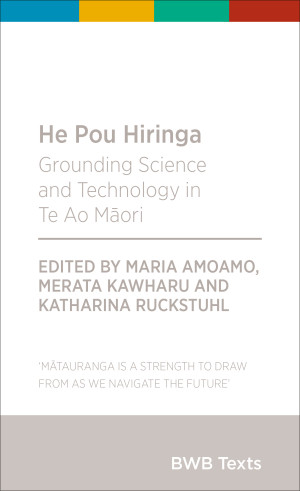5 October 2022 - Vision Mātauranga book has impact in print
5 October 2022 | Read time: 6 minutes

Getting the attention of mainstream media is hard at the best of times, but even more so when it’s research about research. We achieved this in 2021/22.
The book He Pou Hiringa Grounding Science and Technology in Te Ao Māori, which focused on our Vision Mātauranga processes, was a top nomination in the 2021 Summer Reading List for the Prime Minister as selected by the New Zealand Institute of Economic Research.
He Pou Hiringa Grounding Science and Technology in Te Ao Māori was a top nomination in the Prime Minister's 2021 Summer Reading List.
 The collection of essays was edited by our leadership team member, Associate Professor Katharina Ruckstuhl (Ngāi Tahu, Rangitāne) with researchers from the our spearhead research project Building New Zealand’s Innovation Capacity (BNZIC), Dr Maria Amoamo (Whakatōhea) and Professor Merata Kawharu (Ngāti Whātua, Ngāpuhi). Katharina co-leads BNZIC, which is a rare long-term study of how researchers and external stakeholders collaborate. As our Vision Mātauranga theme leader, Katharina has driven BNZIC to particularly gather insights on how cultural capacity (collaborating appropriately with Māori) can enhance human capacity.
The collection of essays was edited by our leadership team member, Associate Professor Katharina Ruckstuhl (Ngāi Tahu, Rangitāne) with researchers from the our spearhead research project Building New Zealand’s Innovation Capacity (BNZIC), Dr Maria Amoamo (Whakatōhea) and Professor Merata Kawharu (Ngāti Whātua, Ngāpuhi). Katharina co-leads BNZIC, which is a rare long-term study of how researchers and external stakeholders collaborate. As our Vision Mātauranga theme leader, Katharina has driven BNZIC to particularly gather insights on how cultural capacity (collaborating appropriately with Māori) can enhance human capacity.
He Pou Hiringa is made up of nine essays by largely Māori writers on big questions about the role of Maori, tikanga and mātauranga in shaping science and technological innovation. It explores the potential for novel approaches, theories, methods and community engagement models in science and technology programmes. It calls for increased Māori participation, initiative and leadership and presents the views of leading Māori thinkers on what technology and science mean for the future.
As well as detailing the possibilities of true integration, the book explains the struggles and additional effort required of Māori researchers to operate within the existing science system, and what should be done at a minimum to relieve some of these additional burdens. It also stands as a sentinel warning of the losses in knowledge already suffered by Māori, and the risks of not adequately protecting the taonga that remains into the future. It notes that such a loss would befall not just Māori, but the whole research and innovation system.
Reviewer Paul Little, writing in North and South magazine called He Pou Hiringa ‘a timely and illuminating book about under-reported issues that affect us all’.
“It is about how Māori are doing or could do science alongside, within or around other ways of doing science,” Little said.
. . . ‘a timely and illuminating book about under-reported issues that affect us all’.
In an interview with Waatea News’ Dale Husband, Katharina explained the editors sought out researchers working in highly technical and cutting-edge areas to understand both their strengths and challenges. She said the book was not just academic.
“It’s about people talking about their experiences and telling their stories . . . I think anybody could be interested in this.”
“It’s about people talking about their experiences and telling their stories . . . I think anybody could be interested in this.”
He Pou Hiringa opens by describing Takarangi - a Māori values-led model of team leadership in science and technology in which teams are made up of the complementary characteristics of Tohunga or knowledge experts, Kaumātua or elders, Rangatira or visionary and strategic leaders, and Pōtiki or youth. The discussion, by Merata with Professor Paul Tapsell (Te Arawa: Mai Maketū ki Tongariro; Tainui / Waikato: Ngati Raukawa ki Maungatautari) examines two SfTI research teams from this lens.
In chapter 7, BNZIC researcher Dr Jordan Waiti (Ngāti Pikiao, Te Rarawa, Ngaati Maahanga) and Dr Erena Wikaire (Ngāpuhi, Ngāti Hine, Te Kapotai, Te Hikutū) highlight the scarcity of indigenous researchers in science, technology, engineering and maths and the importance of fostering these researchers in the early phase of their careers to retain them into the future. They explain that the health and well-being of Māori early career researchers is dependent not just on mental and physical factors, but equally on their spiritual state and wider whānau connectedness. Early career researchers should be supported in all four aspects of wellbeing, including by increasing opportunities to conduct research that is beneficial to whānau, hapū and iwi, and by supporting them to enact kaitiakitanga (guardianship) roles and responsibilities.
The book concludes with a warning from BNZIC researcher Associate Professor Maui Hudson (Whakatōhea, Ngā Ruahine, Te Māhurehure) and co-authors Associate Professor Jane Anderson and Dr Rogena Stirling on the threat facing indigenous people of losing access and control over their own data in a digital economy, due to insufficient legal and non-legal protections. The discussion covers the impacts in both New Zealand and overseas and proposes the adoption of traditional knowledge labels when storing indigenous data and knowledge as a means of asserting ownership and rights.